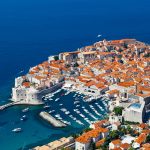As Glas Istre/Dubravko Grakalic writes on the 16th of June, 2019, one professor from the University of Pula weighs in on the Mako shark sightings that have been taking place in the Croatian Adriatic recently.
”Sharks aren’t a threat to us, but we’re a threat to them. If we don’t help in their recovery, the sea will cease to be what it is, a rich, complex treasure trove of life, key to maintaining our lives on the blue planet. It will just become a big, empty body of salt water,” emphasised Dr. Bojan Lazar, a respected professor from the University of Pula.
While amazing to be able to witness and film, the appearance of the Mako shark near Makarska and then in the Korčula channel was perhaps not the best event for some tourists and locals, while for experts, it’s excellent news.
Dr. Bojan Lazar, a professor of conservation biology and a specialist in large sea vertebrae of the Department of Natural and Health Studies at the University of Pula, who teaches students in Koper, Slovenia, as well as in the Croatian capital of Zagreb, says that sharks are a necessary part of the marine ecosystem, and that the chances of seeing a replay of the classic film ”Jaws”, which sent out an extremely incorrect and damaging image of sharks into the world, is far smaller than the chances of being hit by a car while buying ice cream are.
In the vicinity of Makarska, a somewhat rare species of shark, a Mako shark, showed up and was far from camera shy. Mako sharks were once much more present in the Croatian Adriatic than they are today.
”Judging by the footage, it was a Mako shark that was filmed in Makarska. It looks like a juvenile animal, that is, a young shark that is known to approach closer to the coastline due its diet generally being made up of smaller fish. Older and bigger specimens of this species are extremely fast, eating lobster fish, swordfish or tuna, while sexually immature, juvenile specimens often approach the coastline to feed on smaller types of fish,” explains Dr. Lazar and says: “In Croatia, the Mako shark holds the status of a critically endangered species and is thus protected by law. It used to be part of a rich marine fauna both in the Adriatic and in the Mediterranean sea.”
The Mako shark belongs to the top predators of the marine system of pelagic sharks. The global populations of this shark species worldwide have been reduced in the last fifty years. This means that today, in the world’s oceans, there are only three to five percent of these big sharks. In addition to the Blue shark, the Mako shark is the fastest species of shark, and can reach speeds of 74 kilometres per hour when chasing its target, giving its prey little chance of escape.
Professor Lazar says that the appearance of Mako sharks in the Croatian Adriatic today, unfortunately, is a rarity. Recent research shows that since the end of the Second World War to today, the number of large sharks in the Adriatic has decreased by over 94 percent, while some species have sadly completely disappeared.
What makes the recent footage of this beautiful and seeminly very calm young Mako shark even more amazing is that the chance to actually be able to watch Mako sharks in the Adriatic sea today is rare. Since 1948, only sixty have been noticed, and these were mostly juvenile, sexually immature animals, emphasised Dr. Lazar.
It’s interesting to note that in Croatia, archaic names are still used for sharks. The Great White Shark is still often referred to as the ljudožder in Croatia. This old Croatian word indicates that these sharks are blood thirsty and want to hunt and eat humans, which is not only incorrect but very damaging for their already shaky reputation.
These names were given at a time when we didn’t really understand that sharks aren’t mindless killing machines, and when we were very, very afraid of them. As stated, these inflammatory old names for sharks go hand in hand with the wrong perception many people still have of sharks, despite the fact that attacks are extremely rare and are almost always cases of mistaken identity, with the shark immediately retreating when realising that their target is in fact a human, and not a seal or other marine animal that it would typically prey upon.
The professor went on to explain that for many decades, sharks were hunted and killed out of fear.
The main message this Pula professor and marine expert wants to express is that the presence of Mako sharks in the Croatian Adriatic is something to be celebrated. View footage of the shark here, here and here.
Seen a Mako shark while sailing in the Adriatic? Send us your photos or videos!
Follow our dedicated lifestyle page for much more.








